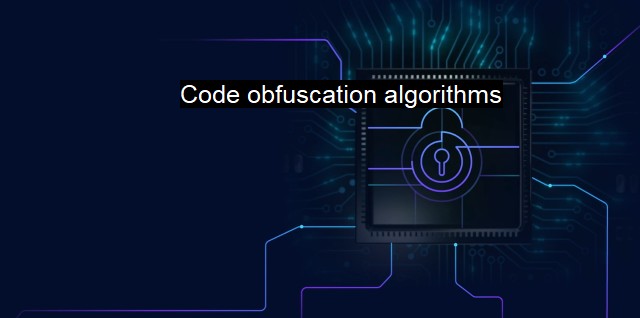What are Code obfuscation algorithms?
The Importance of Code Obfuscation Algorithms in Cybersecurity and Antivirus Contexts: Concealing Program Intent to Prevent Reverse Engineering and Evade Antivirus Detection
Code obfuscation algorithms are critical instruments utilized mostly in the cybersecurity field. They play a significant role primarily in safeguarding premium proprietary software assets from being exploited and misused. Like many terminologies in the cybersecurity constellation, the phrase "code obfuscation algorithms" may sound sophisticated. Therefore, unravelling its elements can be of great help in understanding what it essentially entails.In simple terms, "code obfuscation" implies making computer code more complex and trickier to comprehend or decipher. If developers leave the code base readily accessible and understandable, it potentially subjects the computer software to intrusion and malicious activities such as reverse engineering, alteration, or replication of the code. From a technical perspective, the general functioning of the software or program does not change at all once obfuscated. The real aim is to mask the internal mechanics whilst maintaining the original flow of the program.
There, the "algorithms" part comes in. An algorithm in computer terms describes a set of rules or even a process that a software program uses to solve problems and perform activities. code obfuscation algorithms are sets of complex instructions employed to make the source code more difficult to read and decode.
Different types of obfuscation algorithms are utilized for separate purposes, mainly based on the needed security level and the particular pitfalls to be defended against. Some of these algorithms, particularly in software development, include identifier renaming, data obfuscation, control flow obfuscation, preventative obfuscation, and layout obfuscation, to just mention a few.
Identifier renaming replaces variable and function names with random or unrelated symbols, making it hard for potential attackers to interpret. Control flow obfuscation, as another instance, alters the execution path of the program without changing its output. Meaning it confuses the intruders trying to understand the operation of the program.
In the cybersecurity realm, obfuscation algorithms are excessively used, primary in antivirus programs. The primary purpose is to elude detection by virus and malware, which often analyze the code to understand how the program works. An antivirus program utilizes such methods to decode and analyze viruses encrypted or hidden by attackers using certain obfuscation mechanisms.
Simultaneously, hackers and cybercriminals frequently apply code obfuscation to alter their malicious code to bypass the detection of antivirus systems. This technique is recognized as polymorphic or metamorphic code. Paradoxically, the same mechanisms aimed to improve security can also be misused in a manner to compromise it. This cybercrime strategy up-surges the complexity of cyber threats, requiring antivirus and intrusion detection solutions that can effectively cope with such advanced techniques.
Recognizing that obfuscation is an essential tool in both creating and breaking cybersecurity defenses can assist in comprehending cybersecurity's inherent challenge – it's continually evolving nature. This learning overcomes the obfuscation barrier on both fronts — preventing attacks where feasible and, if an assail attempts to camouflage their tracks, dismantle the techniques they use to obfuscate their activities. Code obfuscation algorithms, when implemented correctly, can contribute significantly to the protection of valuable software assets and maintain the integrity of our increasingly digital world. they pose a substantial challenge to the cybersecurity space due to their potential abusive utilization. Consequently, demand for innovative solutions and proactive methods is continually high to endure this ever-evolving cyber arms race.

Code obfuscation algorithms FAQs
What is code obfuscation?
Code obfuscation is a process of modifying the source code in such a way that it becomes harder to understand or reverse engineer, while still maintaining its functionality. The purpose of code obfuscation is to protect software from being reverse engineered, analyzed or modified by unauthorized users.Why do developers use code obfuscation algorithms?
Developers use code obfuscation algorithms to make it difficult for malicious users to understand and modify their code. This can help prevent unauthorized access, reverse engineering, and other forms of cyber attacks. Obfuscation also makes it difficult for antivirus software to detect and analyze the code, which can help protect against malware.What are some common code obfuscation techniques?
Some common code obfuscation techniques include renaming variables and functions, adding junk code, using encryption or hashing, code splitting and merging, using control flow obfuscation, and code virtualization. These techniques can make it difficult for an attacker to understand the code's function and structure, and disrupt any analysis tools that are used.Are there any downsides to code obfuscation?
Yes, there are some downsides to code obfuscation. For one, it can make debugging and maintenance more difficult, as the code becomes more complex and harder to understand. Additionally, obfuscation can increase the size of the code, which can impact performance and increase the time required for compilation. Finally, obfuscation is not a foolproof solution, as determined attackers can still find ways to reverse engineer the code or overcome the obfuscation.| | A | | | B | | | C | | | D | | | E | | | F | | | G | | | H | | | I | | | J | | | K | | | L | | | M | |
| | N | | | O | | | P | | | Q | | | R | | | S | | | T | | | U | | | V | | | W | | | X | | | Y | | | Z | |
| | 1 | | | 2 | | | 3 | | | 4 | | | 7 | | | 8 | | |||||||